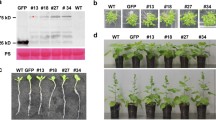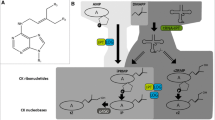Abstract
Northern corn leaf blight caused by Setosphaeria turcica is one of the most important fungal diseases of maize. We previously cloned and analyzed the gene encoding protein kinase C (PKC) in S. turcica, as this Ca2+ signaling component is required for growth and pathogenicity of several other plant pathogenic fungi. Here, we assessed the effect of PKC knockout on S. turcica pathogenicity using four quinic-acid-inducible PKC antisense mutants. The conditional mutants enabled us to study the role of PKC in growth, germination, appressorium development, and pathogenicity despite the fact that constitutive PKC knockout is typically lethal in filamentous fungi. The growth rates of the mutants were the same as that of the wild type (WT) on PDA medium but were much lower on PDA medium that contained the inducer 15 mM quinic acid. Conidial germination and appressorium development were almost completely abolished in the induced mutants, and penetration experiments showed that appressoria from the WT could penetrate cellophane, whereas those of the induced mutants could not. Inoculation experiments showed that the mutant strains failed to produce visible lesions on unwounded maize leaves, although they were able to infect wounded leaves, suggesting that they were impaired in the process of host penetration. Characterization of PKC antisense mutants thus highlighted multiple roles of PKC in S. turcica pathogenicity, laying a foundation for understanding and exploiting a key signal transduction pathway in plant pathogenic fungi.




Similar content being viewed by others
Data availability
The data supporting the findings in this study are available from the corresponding author upon reasonable request.
References
An XL, Dong JG, Han JM (2001) RAPD analysis of Exserohilum turcicumi. CTAB method of isolating DNA from Exserohilum turcicum for RAPD. J Agricultural Univ Hebei 24:244–248
Buhr TL, Oved S, Truesdell GM et al (1996) A kinase-encoding gene from Colletotrichum trifolii complements a colonial growth mutant of Neurospora crassa. Mol Gen Genet 251(5):565
Dean RA, Talbot NJ, Ebbole DJ et al (2005) The genome sequence of the rice blast fungus Magnaporthe grisea. Nature 434(7036):980–986
Dickman MB, Ha YS, Yang Z et al (2003) A protein kinase from Colletotrichum trifolii is induced by plant cutin and is required for appressorium formation. Mol Plant Microbe Interact 16(5):411–421
Dong JG, Fan YS, Gui XM et al (2008) Geographic distribution and genetic analysis of physiological racesof Setosphaeria turcica in northern China. Am J Agri Biol Sci 3(1):389–398
Gong XD, Feng SZ, Zhao J et al (2017) StPBS2, a MAPK kinase gene, is involved in determining hyphal morphology, cell wall development, hypertonic stress reaction as well as the production of secondary metabolites in northern corn leaf blight pathogen Setosphaeria turcica. Microbiol Res 201:30–38
Gu SQ, Li P, Wu M et al (2014) StSTE12 is required for the pathogenicity of Setosphaeria turcica by regulating appressorium development and penetration. Microbiol Res 169(11):817–823
Heinisch JJ, Rodicio R (2018) Protein kinase C in fungi-more than just cell wall integrity. FEMS Microbiol Rev 42(1):22–39
Ichinomiya M, Uchida H, Koshi Y et al (2007) A protein kinase C-encoding gene, pkcA, is essential to the viability of the filamentous fungus aspergillus nidulans. Biosci Biotechnol and Biochem 71(11):2787–2799
Inoue M, Kishimoto A, Takai Y et al (1977) Studies on a cyclic nucleotide-independent protein kinase and its proenzyme in mammalian tissues. II. Proenzyme and its activation by calcium-dependent protease from rat brain. J Biol Chem 252(21):7610–7616
Islam MT, Tiedemann AN, Laatsch H (2011) Protein kinase C Is likely to be involved in zoosporogenesis and maintenance of flagellar motility in the Peronosporomycete zoospores. Mol Plant Microbe Interact 24(8):938–947
Kawano T, Inokuchi J, Eto M et al (2021) Activators and inhibitors of protein kinase C (PKC) their applications in clinical trials. Pharmaceutics 13(11):1748
Kim JC, Crary B, Chang YC et al (2012) Cryptococcus neoformans activates RhoGTPase proteins followed by protein kinase C, focal adhesion kinase, and ezrin to promote traversal across the blood-brain barrier. J Biol Chem 287(43):36147–36157
Kojima K, Kikuchi T, Takano Y et al (2002) The mitogen-activated protein kinase gene MAF1 is essential for the early differentiation phase of appressorium formation in Colletotrichum lagenarium. Mol Plant Microbe Interact 15(12):1268–1276
Lengeler KB, Davidson RC, D’Souza C et al (2000) Signal transduction cascades regulating fungal development and virulence. Microbiol Mol Biol Rev 64(4):746–785
Li P, Zhang XJ, Lin YB et al (2018) The heterotrimeric G protein γ Stgg1 is required for conidiation, secondary metabolite production and pathogenicity of Setosphaeria turcica. Biotechnol Biotec Eq. 32(4):1–7
Liu BH (2019) Influence and mechanism of different hard matrix on infection ability in Setosphaeria turcica. Hebei Agricultural Univercity, Hebei Province
Liu YW, Shen S, Hao ZM et al (2022) Protein kinase a participates in hyphal and appressorial development by targeting Efg1-mediated transcription of a RabGTPase in Setosphaeria turcica. Mol Plant Pathol 23(11):1608–1619
Ma YH, Liang S, Zhang YC et al (2018) Development of anti-fungal pesticides from protein kinase inhibitor-based anticancer agents. Eur J Med Chem 148:349–358
Meng YN, Zeng FL, Hu JJ et al (2022a) Novel factors contributing to fungal pathogenicity at early stages of Setosphaeria turcica infection. Mol Plant Pathol 23(1):32–44
Meng YN, Zhang XJ, Zeng FL et al (2022) Transcriptional regulation of secondary metabolism and autophagy genes in response to DNA replication stress in Setosphaeria turcica. J Integr Agr. https://doi.org/10.1016/j.jia.2022.07.002
Merlini L, Bolognesi A, Juanes MA et al (2015) Rho1-and Pkc1-dependent phosphorylation of the F-BAR protein Syp1 contributes to septin ring assembly. Mol Biol Cell 26(18):3245–3262
Oeser B (1998) PKC1, encoding a protein kinase C, and FAT1, encoding a fatty acid transporter protein, are neighbors in Cochliobolus heterostrophus. FEMS Microbiol Lett 165:273–280
Penn TJ, Wood ME, Soanes DM et al (2015) Protein kinase C is essential for viability of the rice blast fungus Magnaporthe oryzae. Mol Microbiol 98(3):403–419
Perkins JM, Pedersen ML (1987) Disease development and yield losses associated with northern leaf blight on corn. Plant Dis 71(10):940
Shen S, Hao ZM, Gu SQ et al (2013) The catalytic subunit of cAMP-dependent protein kinase a StPKA-c contributes to conidiation and early invasion in the phytopathogenic fungus Setosphaeria turcica. FEMS Microbiol Lett 343(2):135–144
Shen Z, Li Y, Gasparski AN et al (2017) Cardiolipin regulates mitophagy through the protein kinase C pathway. J Biol Chem 292(7):2916–2923
Sugahara A, Yoshimi A, Shoji F et al (2019) Novel antifungal compound Z-705 specifically inhibits protein kinase C of filamentous fungi. Appl Environ Microb 85(10)
Sussman A, Huss K, Chio L et al (2004) Discovery of cercosporamide, a known antifungal natural product, as a selective Pkc1 kinase inhibitor through high-throughput screening. Eukaryot Cell 3(4):932–943
Takano Y, Kikuchi T, Kubo Y et al (2000) The Colletotrichum lagenarium MAP kinase gene CMK1 regulates diverse aspects of fungal pathogenesis. Mol Plant Microbe Interact 13(4):374
Turrà D, Segorbe D, Di Pietro A (2014) Protein kinases in plant-pathogenic fungi: conserved regulators of infection. Annu Rev Phytopathol 52:267–288
Valdivia RH, Schekman R (2003) The yeasts Rho1p and Pkc1p regulate the transport of chitin synthase III (Chs3p) from internal stores to the plasma membrane. Proc Natl Acad Sci USA 100(18):10287–10292
Van Inghelandt D, Melchinger AE, Martinant J et al (2012) Genome-wide association map** of flowering time and northern corn leaf blight (Setosphaeria turcica) resistance in a vast commercial maize germplasm set. BMC Plant Biol 12(1):56
**a ZJ, Ying C, An WL (2005) Ca2+ signaling pathway involved in bipolaris maydis conidium germination and appressorium formation. Microbiol China 32(4):1–4
**e JL, Grahl N, Sless T et al (2016) Signaling through Lrg1, Rho1 and Pkc1 governs Candida albicans morphogenesis in response to diverse cues. PLoS Genet 12(10):e1006405
Yamauchi J, Takayanagi N, Komeda K et al (2004) cAMP-PKA signaling regulates multiple steps of fungal infection cooperatively with Cmk1 MAP kinase in Colletotrichum lagenarium. Mol Plant Microbe Interact 17(12):1355–1365
Yang ZH, Dickman MB (1999) Colletotrichum trifolii mutants disrupted in the catalytic subunit of cAMP-dependent protein kinase are nonpathogenic. Mol Plant Microbe Interact 12(5):430
Yano K, Uesono Y, Yoshida S et al (2013) Mih1/Cdc25 is negatively regulated by Pkc1 in Saccharomyces cerevisiae. Genes Cells 18(6):425–441
Zeng FL, Meng YN, Hao ZM et al (2020) Setosphaeria turcica ATR turns off appressorium-mediated maize infection and triggers melanin-involved self-protection in response to genotoxic stress. Mol Plant Pathol 21(3):401–414
Zhang LH, Liu YH, Dong JG et al (2003) Isolation and purification of specific toxin fractions produced by Exserohilum turcicum. Acta Phytopathologica Sinica 33(1):67–71
Zhang SR, Hao ZM, Wang LH et al (2012) StRas2 regulates morphogenesis, conidiation and appressorium development in Setosphaeria turcica. Microbiol Res 167(8):478–486
Zheng FC, Wang KD, Wang WH (2007) Advance research on appressorium of Colletotrichum. Chin Agric Sci Bull 23(1):265–270
Acknowledgements
This work was supported by grants from the Natural Science Foundation of Hebei Province (C2022204138), the National Key Research and Development Plan (2018YFD0200607), and the China Agriculture Research System (CARS-02-25). We are grateful to all lab members for helpful discussions and suggestions for this work.
Author information
Authors and Affiliations
Corresponding authors
Ethics declarations
Conflict of interest
The authors declare no conflict of interests.
Additional information
Publisher’s Note
Springer Nature remains neutral with regard to jurisdictional claims in published maps and institutional affiliations.
Rights and permissions
Springer Nature or its licensor (e.g. a society or other partner) holds exclusive rights to this article under a publishing agreement with the author(s) or other rightsholder(s); author self-archiving of the accepted manuscript version of this article is solely governed by the terms of such publishing agreement and applicable law.
About this article
Cite this article
Li, P., Sun, H., Dong, J. et al. Protein kinase C is required for the pathogenicity of Setosphaeria turcica on maize. J Plant Pathol 105, 683–693 (2023). https://doi.org/10.1007/s42161-023-01379-0
Received:
Accepted:
Published:
Issue Date:
DOI: https://doi.org/10.1007/s42161-023-01379-0




